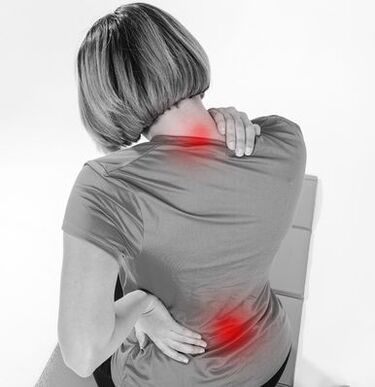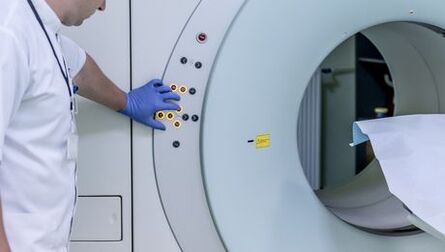
Feel the feeling of numbness of pain and limbs behind?These are the first signs of osteocondrosis.In his way of life, sitting work, cargo and spine, and spine, and loses moisture and lose moisture, make them lose harm.
With cervical osteochondrosis, degenerative changes occur on intervertebral disks.Only the discs are damaged, but also spines and joints in the cervical region.If you do not treat a long time, the patient's overall health is deteriorating: permanent headache, the appearance of the vertebrate, the deterioration of the brain circulation, resulting in cognitive functions.
Reasons for the development of osteocondrosis
A seating position of the neck progresses leads to the development of cervical diseases.In this case, intervertebral disks, excessive pressure, which is squeezed in the nucleus and blood vessels.This position is in the workplace in front of a human computer.Therefore, office workers are subject to the development of the most cervical spine osteocondrosis.

In addition, the reasons for the development of pathology may be:
- Proper download distribution while wearing bags;
- an extremely soft sleeping place (the spine bends in an unnatural form);
- genetic tendency;
- lack of vitamins and trace elements in the diet;
- endocrine system disorder;
- breach of spine curvature and posture during the active growth of the body;
- Injuries of cervical vertebrae;
- The presence of bad habits.
Stages of the disease
The development of the pain of the pain of the pain can be determined by an experienced doctor after the exam and palpation to determine whether the cervical spine is the development of osteocondrosis and development of the development phase of the disease.In general, cervical osteochondrosis is holding four stages of development:
- Nuclear Pulposus - The central part of the intervertebral disk in the first stage is subject to mild dehydration.As a result, the support of intervertebral disks and shock -bing functions are gradually lost.In the first stage, you will live in pain with sudden movements, hypothermia and stay in a pose for a long time.
- The second phase of development is characterized by the views of the conditions and spasms that prevent the capillaries and blood vessels that prevent normal blood circulation.As a result, the frame of intervertebral disk is thin, correspondent (forward or retreated).Osteophytes are still under the influence of cargo in the cervical vertebra.The feelings of pain are localized together, there may be a cervical vertebrae displacement with sharp turns and head tors.
- Extrusion is created as a result of thinning intervertebral discs.The edge of the pulpoose nucleus breaks the fibrous ring and goes beyond the edges of the vertebral body.Muscles and nerve ends are squeezed.Feel with pain in neck, back and limbs.
- In the fourth stage of the disease, intervertebral disks are modified and formed by Hernias from the side of the center and side.In addition, scars occur on the disks caused by the inaction of the affected association.The patient is experiencing constant back pain, which is given to other parts of the body, constantly fatigue, transforming the asymmetry of highways.

Symptoms of cervical osteocondrosis
The symptoms of the osteocondrosis of cervical spine reveals themselves differently in the development phase of pathology.In the early stages, it can actually happen without having signs.The pain in the neck and the back can only appear in a pose, sharp inclination or rotation only for a long time.
In the next stages of development, a crisis in the waist is heard, the pain in the back is given to other limbs, and the parts of the body are suitable.There are these with the formation of osteoophyte and extrusion:
- headache and parietal part of the head;
- Impairment of language speech and language;
- Decreased sensitivity of neck skin;
- breathing disorder;
- Swearing of blood pressure;
- heartbeat disorders;
- noise and stagnation in the ears;
- Don't lose.
The symptoms of the osteocondrosis of cervical spine in women are more pronounced than men.It is due to the fact that women have a more fragile structure of vascular diseases and waist bone segments.The symptoms of the disease begin to appear when intervertebral disk changes occur.This leads to a normal blood circulation and causes severe headaches, dizziness and neurosis.Complications of the disease in women occur during menopause during menopause when a hormonal background of the body is often occurred during menopause.
The symptoms of cervical osteocondrosis in men are similar to women, erectile dysfunction can be observed separately.
The headache for cervical osteochondrosis is caused by blood circulatory disorders in the brain and spinal cake.When vertebrae slips, the drops are squeezed and the oxygen content in the blood decreases.Unfortunately, such pain cannot pass after strong painkillers.Therefore, it is important to be comprehensive to solve the problem.The dizziness for cervical osteochondrosis can be accompanied by the appearance of noise in the ears in the eyes.This occurs because the spasm muscles are caused by a reduction in the entrance to the brain.
The cervical spine is in the throat in the throat, burn, burn, burn, breathe, and difficulty with muscle cramps - this is a general case.The disease provokes the nervous fibers of the cervical spine and squeezes the neck.The disorders of nerve impulses cause sore throat.
The spasms of blood vessels are jumping in blood pressure due to irritating the nervous ends.The increasing pressure of low pressure in osteocondrosis shows that blood supply to individual areas of the brain is concerned about the survivor of the verbal arery by intervertebral disks.As a result, oxygen hunger occurs and blood pressure rises.

What is the diagnosis of osteocondrosis of cervical spine osteocondrosis?
The pathological diagnosis begins with a specialist consultation.In the first manifestations of osteocondrosis, contact the rheumatic, neurologist, surgeon or traumatologist.The doctor will ask about the symptoms and frequency of manifestations, and the expert's disease must ensure the results of the full historical and early research (if any).The specialist will conduct visual inspection and palpation, and will be directed for tests.During the exam, doctor, neck, muscle tone, skin sensitivity, paid special attention to the sensitivity of the skin and reveal the most painful areas.
The condition of muscles, ligaments, blood vessels, inflammatory processes or tumors, to discover a known and secure diagnostic method, to identify the MRI of the cervical waist.MRI is located on a table that can be retreated with a patient back during osteocondrosis.The rollers are placed on the head to eliminate muscle tension and are made of limbs with belts.Any insignificant action in the procedure may affect the quality of the result.Next, the table stands for tomography.The procedure does not cause pain.Tomography creates a heavy noise in the scan, so you can use the headset to avoid worries.
If MRI is contraindicated, there are other diagnostic methods such as computer tomography and radiography.X -Ray is only suitable for initial diagnosis and does not give a layer-affected tissue.However, this work is the simplest and most economical that allows you to investigate the body of the patient in several forecasts.Roontegal radiography cannot be done frequently due to the strong radiation load on the body.
During the calculated tomography, the scan is done using one or more ionizing rays.They pass through the human body and are recorded by the detectors.Detectors move in the opposite direction along the patient's body and are set to 6 million signals.Different tissue density is shown in images by clearly defining the boundaries of organs and the affected regions in the description.The procedure allows you to receive a layered image.

Treatment of osteocondrosis of cervical spine
How to treat cervical osteochondrosis will be treated, only a doctor's disclosure and determine the results of the apparatus diagnostics after examination.If the disease is diagnosed in an early stage, the treatment will take conservative roads.It is important to comply with an integrated approach in the treatment of osteocondrosis - to take medication, engaging in physiotherapy, therapeutic massage and avoiding severe physicality.
First you need to stop pain.For this purpose, the analgesics of local activity are determined by painkillers.Designed to wear an orthopedic collar with strong muscle cramps.After removing the pain syndrome, it is necessary to stop the inflammatory process and restore normal blood circulation.To do this, antioxidant, anti-inflammatory therapy is being carried out.Additional measures, therapeutic exercises, are set to swimming.You can deal with physical education with both home and coach.
If osteochondrosis became violent, the doctor can determine surgical intervention.The operation rarely rarely researches the displacement of scoliosis, intervertebral disks, intervertebral disks, intervertebral disks, curvature or spine injuries.
The treatment of cervical osteochondrosis in women is not different from men's treatment.However, doctors often recommend foreign compresses to warm and strengthen the muscles of the neck to women.
Experts recommend to prevent various back diseases from early childhood.To do this, you should form the right post while walking on the desktop and staying.The correct strengthening of full nutrition and back muscles will help prevent negative results in the future.



































